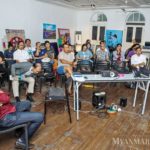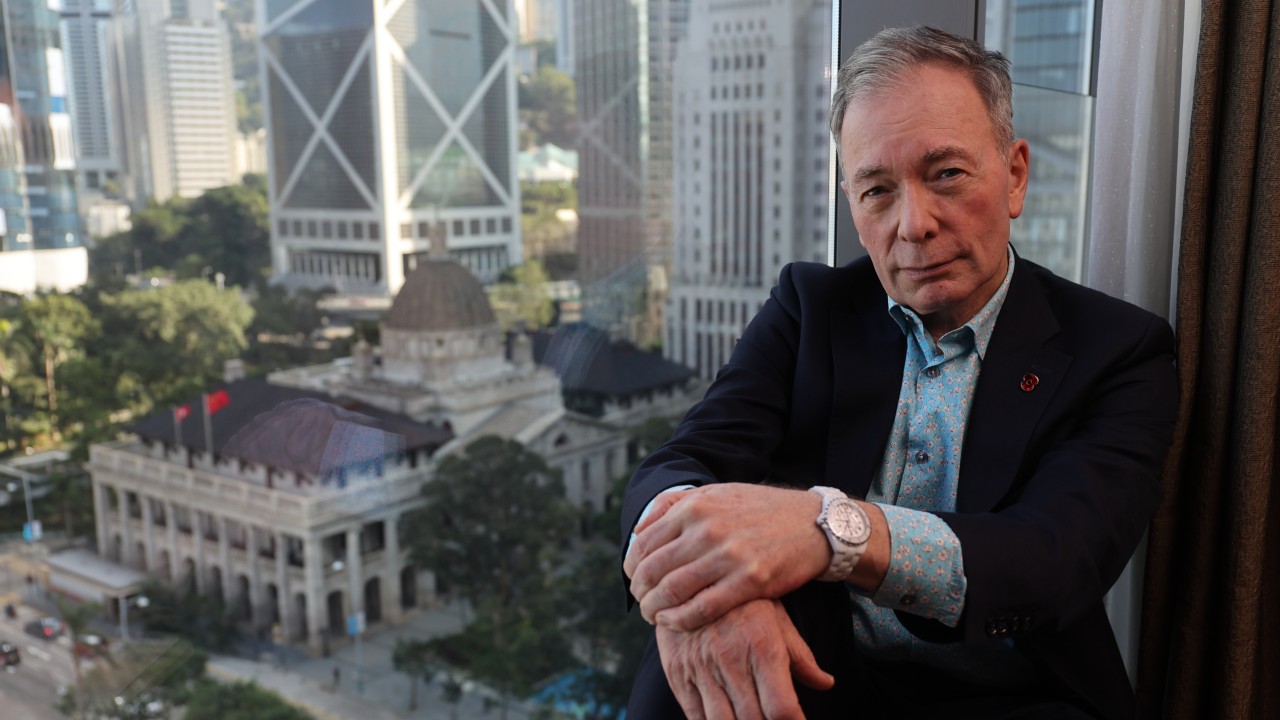Los rastreadores
2014 - Film & Video (Film & Video)
23:00 minutes
Claudia Joskowicz
Los rastreadores is a two-channel video by Claudia Joskowicz narrating the story of a fictitious drug lord, Ernesto Suarez, whose character is based on the well-known Bolivian drug dealer, Roberto Suárez. In the video, Suarez returns home from prison and survives a massacre that takes place at his home in Bolivia. Told in four chapters, the story is inspired by John Ford’s American Western classic film The Searchers (1956), this work similarly focuses on the politicized atmosphere of Bolivian history, searching for cues of race and alienation. Bringing together a Nazi officer, a Bolivian drug lord, and indigenous peoples of Bolivia—perceived to be inferior by mestizos and people of European origin—in one story, Joskowicz exposes the hidden power relationships and hierarchies of Bolivia’s history, problematizing race and class.
Claudia Joskowicz is a video and installation artist working at the intersection of landscape, history, and memory. Her works form unsettling scenes that reimagine public and private histories of Latin American individuals and communities. Blurring the line between documentary and fiction, these works often involve violent images to bring traumas to the present, and to offer a moment of catharsis for the ones who were affected by these incidents in some way. In her works, Joskowicz intentionally gives a great amount of power and agency to the camera, reminding the viewer of their passive role in the construction of history. In this way, the artist critiques technology as a medium that easily manipulates one’s interpretation of history, controlling what gets to survive in the public collective memory. As Joskowicz’s camera wanders around the landscape, or focuses on one of the protagonists in her stories, the rest of the scene—and with it, other possible perspectives—fall into the dark, constructing yet another subjective historical narrative. It’s easy to focus on the slow movement of the camera more so than the actual event being recorded, which Joskowicz harnesses to remind her viewers that history is man-made. When texts or events are taken out of their context and technology is present to create an imaginary cinematic space, any narrative is possible.
Colors:
Related works featuring themes of: » Andes Region, » Cinematic, » Collective History, » Conflict
» see more

© » KADIST
Chen Chieh-Jen
2010Empire’s Borders II – Passage and Empire’s Borders II – Workers are from the three-channel film installation Empire’s Borders II – Western Enterprise, Inc...

© » KADIST
Chen Chieh-Jen
2010Empire’s Borders II – Passage and Empire’s Borders II – Workers are from the three-channel film installation Empire’s Borders II – Western Enterprise, Inc...

© » KADIST
Shilpa Gupta
2009In Untitled (Sword) , addressing histories of colonialism with abstraction, a large steel blade extends from the gallery wall...

© » KADIST
Shilpa Gupta
2008The three monkeys in Don’t See, Don’t Hear, Don’t Speak are a recurring motif in Gupta’s work and refer to the Japanese pictorial maxim of the “three wise monkeys” in which Mizaru covers his eyes to “see no evil,” Kikazaru covers his ears to “hear no evil,” and Iwazaru covers his mouth to “speak no evil.” For the various performative and photographic works that continue this investigation and critique of the political environment, Gupta stages children and adults holding their own or each other’s eyes, mouths and ears...
Other related works, blended automatically
» see more

© » KADIST
Claudia Joskowicz
2008The primary interest in the trilogy is Joskowicz’s use of cinematic space, with long tracking shots that portray resistance to habitual viewing experiences of film and television...

© » KADIST
Chen Chieh-Jen
2010Empire’s Borders II – Passage and Empire’s Borders II – Workers are from the three-channel film installation Empire’s Borders II – Western Enterprise, Inc...

© » KADIST
Chen Chieh-Jen
2010Empire’s Borders II – Passage and Empire’s Borders II – Workers are from the three-channel film installation Empire’s Borders II – Western Enterprise, Inc...

© » KADIST
Bani Abidi
2008The threshold in contemporary Pakistan between the security of private life and the increasingly violent and unpredictable public sphere is represented in Abidi’s 2009 series Karachi ...
Related works sharing similar palette
» see more

© » ARTS EQUATOR
MervEspina and the Green Papaya Art Projects (via The Myanmar Times) | ArtsEquator Thinking and Talking about Arts and Culture in Southeast Asia Articles September 22, 2018 With the support of Japan Foundation and collaboration of Myanm/Art, MervEspina, artist and researcher from Philippines talked about Green Papaya Art Projects whose essence can be rendered as ‘never ripe, never rotten’...
Other works by: » Claudia Joskowicz
» see more

© » KADIST
Claudia Joskowicz
2008The primary interest in the trilogy is Joskowicz’s use of cinematic space, with long tracking shots that portray resistance to habitual viewing experiences of film and television...

© » KADIST
Claudia Joskowicz
2007The primary interest in the trilogy is Joskowicz’s use of cinematic space, with long tracking shots that portray resistance to habitual viewing experiences of film and television...

© » KADIST
Claudia Joskowicz
2015Some Dead Don’t Make a Sound (Hay muertos que no hacen ruido) is a single-channel video by Claudia Joskowicz that features the Mexican legend of the Weeping Woman (La Llorona) as its main protagonist...

© » KADIST
Claudia Joskowicz
2009The primary interest in the trilogy is Joskowicz’s use of cinematic space, with long tracking shots that portray resistance to habitual viewing experiences of film and television...
Related artist(s) to: Claudia Joskowicz » Carla Zaccagnini, » Dirceu Maués, » Adriano Costa, » Gabriel Mascaro, » Moran Shavit, » Akram Zaatari, » Eastern Europe, » Jan Villa, » Liu Wei, » Marcellvs L
» see more

© » KADIST
Carla Zaccagnini
2018De sino à sina (From Bell to Fate) is a six-channel sound installation by Carla Zaccagnini exploring the relationship between modern Brazil and its colonial past...

© » KADIST
Adriano Costa
2014Westminster Agua Viva is made from Westminster City Council(‘s) recycling bin bags, glued together, that the artist has painted and cut or cut and painted...

© » KADIST
Akram Zaatari
1950“While taking the picture it was challenging to make the boys sit properly without moving...
Related works found in the same semantic group
» see more

© » KADIST
KADIST Holiday Get-together, exhibition walk-through of Native Art Department International, Bureau of Aesthetics with artist, writer, and educator tamara suarez porras followed by Cran Royale cocktails and cheese boards to welcome our artist-in-residence Jeamin Cha! tamara suarez porras is an artist, writer, and educator from (south) Brooklyn, New York and based in the San Francisco Bay Area...

© » WHITEHOT
Ruth Gonzales & Lorien Suárez-Kanerva: The Embrace of Nature advertise donate post your art opening recent articles cities contact about article index podcast main December 2023 "The Best Art In The World" "The Best Art In The World" December 2023 Ruth Gonzales & Lorien Suárez-Kanerva: The Embrace of Nature Eric Minh Swenson Art Films: Ruth Gonzales & Lorien Suárez Kanerva, The Embrace of Nature Exhibition Curator Narration by Peter Frank...

© » SOUTH CHINA MORNING POST
Novelist Tony Parsons on the 70s and Debbie Harry, love at first sight and why Hong Kong is his place | South China Morning Post Novelist Tony Parsons on the 70s and Debbie Harry, love at first sight and why Hong Kong is his place Profile The British writer recalls following punk rockers around in the drug-addled 70s, wild times in Wan Chai, falling in love, and finding his voice as a novelist Kate Whitehead + FOLLOW Published: 6:15am, 26 Nov, 2023 Why you can trust SCMP My dad was a Royal Navy commando and was badly wounded in the invasion of Elba (in Italy during World War II), in Operation Brassard...





